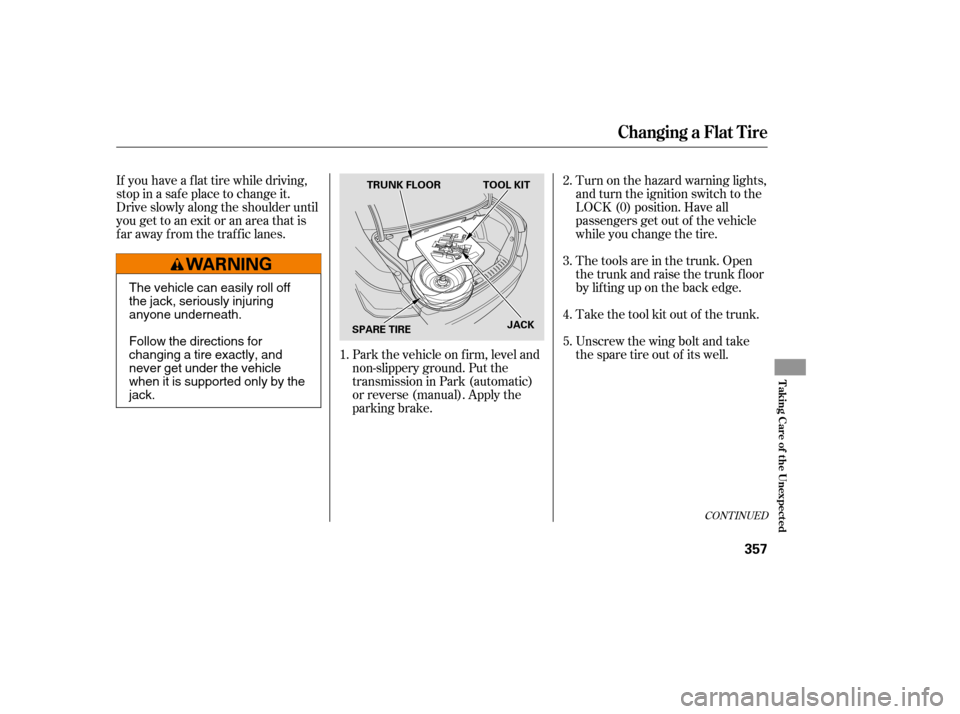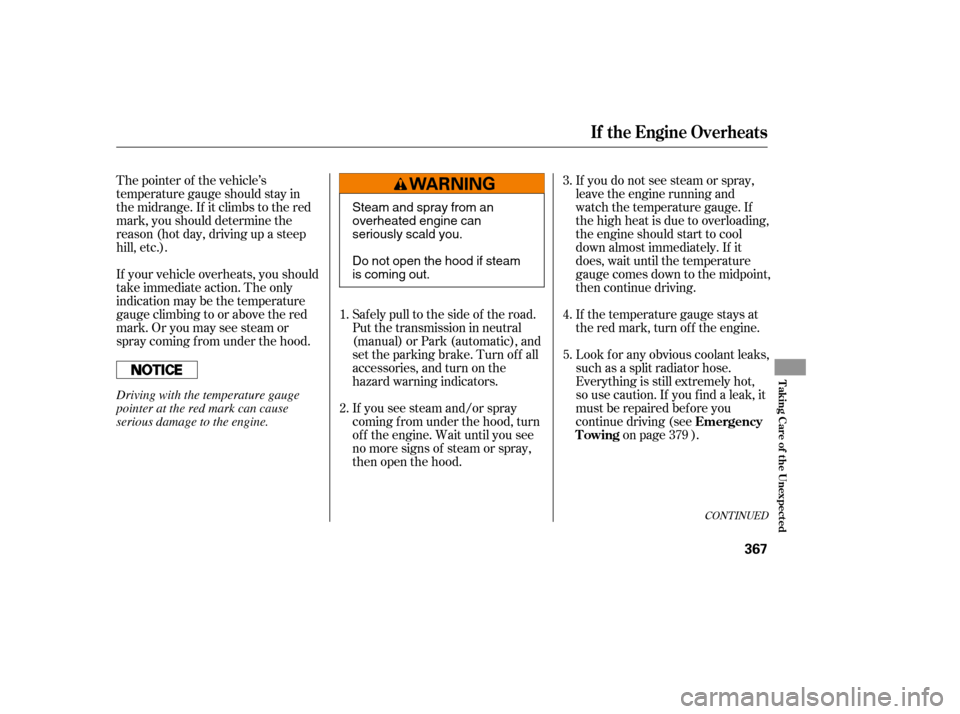Page 376 of 435

Support the f ront wiper blade
arms with a f olded towel or rag so
they do not touch the windshield.
To minimize sticking, apply a
silicone spray lubricant to all door
and trunk seals. Also, apply a
vehiclebodywaxtothepainted
surfaces that mate with the door
and trunk seals.
Cover the vehicle with a
‘‘breathable’’ cover, one made
f rom a porous material such as
cotton. Non-porous materials, such
as plastic sheeting, trap moisture,
which can damage the paint.
Leave the parking brake off. Put
the transmission in reverse
(manual) or Park (automatic).
If possible, periodically run the
engine until it reaches f ull
operating temperature (the
cooling f ans cycle on and of f
twice). Pref erably, do this once a
month.
Block the rear wheels.
If the vehicle is to be stored f or a
longer period, it should be
supported on jackstands so the
tires are of f the ground.
Leave one window open slightly (if
the vehicle is being stored
indoors).
Disconnect the battery.
Vehicle Storage
Maint enance
353
�����—�����—�
���y�
�
�������
�
�y���
�)�����������y���������y
Page 379 of 435

CONT INUED
Park the vehicle on f irm, level and
non-slippery ground. Put the
transmission in Park (automatic)
or reverse (manual). Apply the
parking brake.
If you have a f lat tire while driving,
stop in a saf e place to change it.
Drive slowly along the shoulder until
you get to an exit or an area that is
far away from the traffic lanes.
Turn on the hazard warning lights,
and turn the ignition switch to the
LOCK (0) position. Have all
passengers get out of the vehicle
while you change the tire.
The tools are in the trunk. Open
the trunk and raise the trunk f loor
by lif ting up on the back edge.
Take the tool kit out of the trunk.
Unscrew the wing bolt and take
the spare tire out of its well.
5.
4.
3.
2.
1.
Changing a Flat T ire
T aking Care of t he Unexpect ed
357
TRUNK FLOOR JACK
SPARE TIRE TOOL KIT
The vehicle can easily roll off
the jack, seriously injuring
anyone underneath.
Follow the directions for
changing a tire exactly, and
never get under the vehicle
when it is supported only by thejack.
�����—�����—�
���y�
�
�����������y���
�)�����������y���������y
Page 381 of 435
CONT INUED
Use the extension and the wheel
nut wrench as shown to raise the
vehicle until the f lat tire is of f the
ground.
Remove the wheel nuts, then
remove the f lat tire. Handle the
wheel nuts caref ully; they may be
hot f rom driving. Place the f lat tire
on the ground with the outside
surface facing up.Do not attempt to forcibly pry the
wheel cover of f with a screwdriver or
other tool. The wheel cover cannot
be removed without f irst removing
the wheel nuts.
Bef ore mounting the spare tire,
wipe any dirt of f the mounting
surface of the wheel and hub with
a clean cloth. Wipe the hub
carefully;itmaybehotfrom
driving.
9.
10. 11.LX model
Changing a Flat T ire
T aking Care of t he Unexpect ed
359
WHEEL WRENCH EXTENSIONWHEEL NUT
WHEEL COVER BRAKE HUB
�����—�����—�
���y�
�
�����������y���
�)�����������y���������y
Page 386 of 435

Although this seems like a simple
procedure, you should take several
precautions. Open the hood, and check thephysical condition of the battery.
In very cold weather, check the
condition of the electrolyte. If it
seems slushy or f rozen, do not try
jump starting until it thaws.
To jump start your vehicle:
Turn of f all the electrical
accessories: heater, A/C, audio
system, lights, etc. Put the
transmission in neutral (Manual)
or Park (Automatic), and set the
parking brake.
You cannot start your vehicle with an
automatic transmission by pushing
or pulling it. The numbers in the illustrations
show you the order to connect the
jumper cables.
1. 2.
Jump Start ing
364
2.4engine models
BOOSTER BATTERY
A battery can explode if you do
not follow the correct procedure,
seriously injuring anyonenearby.
Keep all sparks, open flames,
and smoking materials away
from the battery. If a battery sits in extreme cold, the
electrolyte inside can f reeze.
Attempting to jump start with a f rozen
battery can cause it to rupture.
�����—�����—�
���y�
�
�����������y���
�)�����������y���������y
Page 389 of 435

If you do not see steam or spray,
leave the engine running and
watch the temperature gauge. If
the high heat is due to overloading,
the engine should start to cool
down almost immediately. If it
does, wait until the temperature
gauge comes down to the midpoint,
then continue driving.
If the temperature gauge stays at
the red mark, turn off the engine.
Look f or any obvious coolant leaks,
such as a split radiator hose.
Everything is still extremely hot,
so use caution. If you f ind a leak, it
must be repaired bef ore you
continue driving (seeon page ).
The pointer of the vehicle’s
temperature gauge should stay in
the midrange. If it climbs to the red
mark, you should determine the
reason (hot day, driving up a steep
hill, etc.).
If your vehicle overheats, you should
take immediate action. The only
indication may be the temperature
gauge climbing to or above the red
mark. Or you may see steam or
spray coming f rom under the hood.
If you see steam and/or spray
coming f rom under the hood, turn
of f the engine. Wait until you see
no more signs of steam or spray,
then open the hood.
Saf ely pull to the side of the road.
Put the transmission in neutral
(manual) or Park (automatic), and
set the parking brake. Turn of f all
accessories, and turn on the
hazard warning indicators.
1. 2. 3. 4. 5.
379
CONT INUED
Emergency
Towing
If theEngineOverheats
T aking Care of t he Unexpect ed
367
Steam and spray from an
overheated engine can
seriously scald you.
Do not open the hood if steam
is coming out.
Driving with the temperature gauge
pointer at the red mark can cause
serious damage to the engine.
�����—�����—�
���y�
�
�����������y���
�)�����������y���������y
Page 393 of 435

However, if the brake pedal does not
f eel normal, you should take
immediate action. A problem in one
part of the system’s dual circuit
design will still give you braking at
two wheels. You will f eel the brake
pedal go down much f arther bef ore
the vehicle begins to slow down, and
you will have to press harder on the
pedal. If you must drive the vehicle a shortdistance in this condition, drive
slowly and caref ully.
Slow down by shif ting to a lower
gear, and pull to the side of the road
when it is saf e. Because of the long
distance needed to stop, it is
hazardous to drive the vehicle. You
should have it towed and repaired as
soon as possible (see
on page ).
The brake system indicator normally
comes on when you turn the ignition
switch to the ON (II) position, and as
a reminder to check the parking
brake. It will stay on if you do not
f ully release the parking brake.
If the brake system indicator comes
on while driving, the brake f luid level
is probably low. Press lightly on the
brake pedal to see if it f eels normal.
If it does, check the brake f luid level
thenexttimeyoustopataservice
station (see page ).
If the f luid level is low, take your
vehicle to a dealer, and have the
brake system inspected f or leaks or
worn brake pads. If the ABS indicator and the VSA
system indicator come on with the
brake system indicator, have your
vehicle inspected by your dealer
immediately.
326 379
Emergency
Towing
Brake System Indicator
T aking Care of t he Unexpect ed
371
U.S. Canada
�����—�����—�
���y�
�
�������
���y���
�)�����������y���������y
Page 401 of 435

�µ�µ
If your vehicle needs to be towed,
call a prof essional towing service or
organization. Never tow your vehicle
with just a rope or chain. It is very
dangerous.
The operator
loads your vehicle on the back of a
truck.
Therearetwowaystotowyour
vehicle: If , due to damage, your vehicle must
be towed with the f ront wheels on
the ground, do this:
Release the parking brake.
Shif t the transmission to neutral.
Leave the ignition switch in the
ACCESSORY (I) position so the
steering wheel does not lock. With the f ront wheels on the ground,
do not tow the vehicle more than 50
miles (80 km), and keep the speed
below35mph(55km/h).
The tow
truck uses two pivoting arms that go
under the f ront tires and lif t them of f
the ground. The rear tires remain on
the ground.
Leave the ignition switch in the
ACCESSORY (I) position so the
steering wheel does not lock.
Turn of f the engine.
Release the parking brake.
Shif t to D position f or 5 seconds,
then to N.
Start the engine.
Press on the brake pedal. Move
the shif t lever through all its
positions.
Manual transmission:
Automatic transmission:
CONT INUED
Flat -bed EquipmentWheel-lif t Equipment
T his is the best way to
transport your vehicle.
This is an acceptable
way to tow your vehicle.
Emergency T owing
T aking Care of t he Unexpect ed
379
Improper towing preparation will
damage the transmission. Follow the
above procedure exactly. If you cannot
shif t the transmission or start the
engine (automatic transmission), your
vehicle must be transported with the
f ront wheels of f the ground.
�����—�����—�
���y���������������y���
�)�����������y���������y
Page 406 of 435

�µ
�µ �µ�µ�µ�µ�µ�µ�µ�µ�µ�µ�µ�µ�µ �µ �µ�µ�µ�µ�µ
�Î �Î�Î
�Î
�Î �Î
�Î
�Î
�Î
Specif icat ions (2.4engine models)
T echnical Inf ormation
385
Lights Battery Fuses
Tires
Alignment
12 V 60 W (HB3)
12 V 51 W (HB4)
12 V 21/5 W
21 W
12 V 21 W
Headlights
Front turn signal/parking lights
Front side marker lights
Rear turn signal lights
Back-up lights
Stop/taillights
License plate lights
High-mount brake light
Ceiling light
Spotlights
Trunk light
Front door courtesy lights
Vanity mirror lights 12 V 1.1 W
12 V 2 CP
12 V 5 W
12 V 8 W
12 V 8 W
12 V 21 W
12 V 5 W
12 V 21/5 W
12 V 3 CP
12 V
Capacity 12 V 12 V
12 V
12 V
12 V
12 V36 AH/5 HR
38 AH/5 HR
45 AH/20 HR
47 AH/20 HR
52 AH/5 HR
65 AH/20 HR Interior
Under-hood Size
Pressure
P215/60R16 94H
P225/50R17 93V
T135/80D16 101M
32 psi (220 kPa , 2.2 kgf/cm
)
30 psi (210 kPa , 2.1 kgf/cm)
60 psi (420 kPa , 4.2 kgf/cm
)
Toe-in
CamberCaster 0.00 in (0.0 mm)
0.08 in (2.0 mm)
0°
1°
3°48’
See page 377 or the fuse label
attached on the side panel.
See page 378 or the fuse label
attached to the inside of the fuse
box door.
See page 376 or the fuse box
cover.
HighLow
: PZEV engine model Passenger’s side
Driver’s side
Front/Rear
Spare
Front/Rear
Spare
1: 2:
FrontRear
FrontRear
Front
(Amber)
LX, LX-P
EX, EX-L
2
1
2
1
�����—�����—�
���y�
�������������y���
�)�����������y���������y